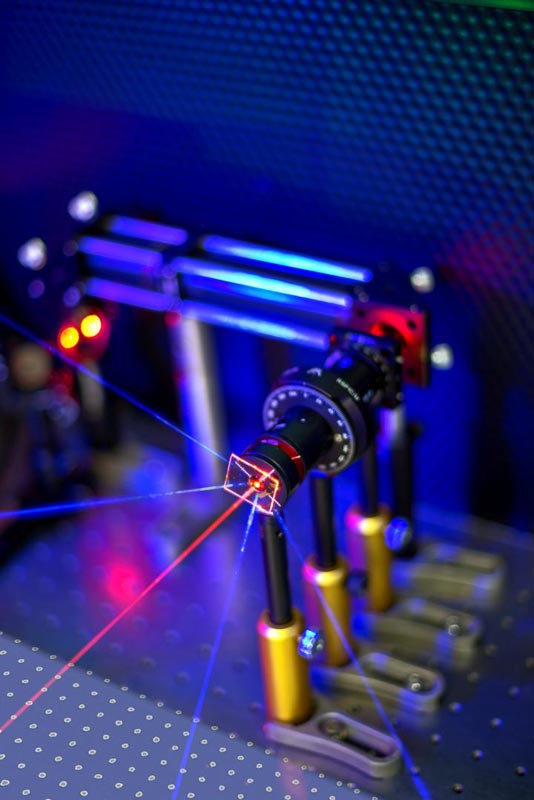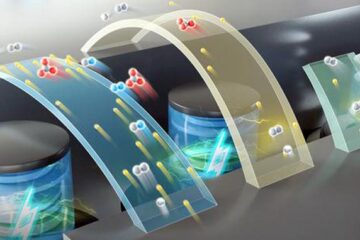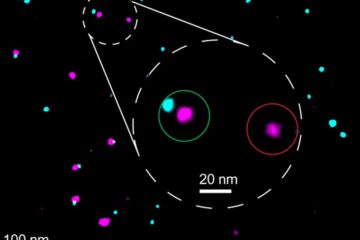Ultra-sensitive sensor with gold nanoparticle array

In the sensor, gold nanodisks are arranged in squares, shown bottom-left. The arrangement causes the sensor to emit UV light (in blue). Credit: V.K Valev and D.C Hooper
The sensor is made up of a series of gold disk-shaped nanoparticles on a glass slide. The team at Bath discovered that when they shone an infra-red laser at a precise arrangement of the particles, they started to emit unusual amounts of ultra violet (UV) light.
This mechanism for generating UV light is affected by molecules binding to the surface of the nanoparticles, providing a means of sensing a very small amount of material.
The researchers, from the University of Bath's Department of Physics, hope that in the future they can use the technology to develop new ultra-sensitive sensors for air pollution or for medical diagnostics.
Dr Ventsislav Valev, Royal Society Research Fellow and Reader in Physics at the University of Bath, led the work with Research Associate David Hooper.
He explained: “This new mechanism has great potential for detecting small molecules. It is 100 times more sensitive than current methods.
“The gold nanoparticle disks are arranged on a glass slide in a very precise array – changing the thickness and separation of the disks completely changes the detected signal.
“When molecules bind to the surface of a gold nanoparticle, they affect the electrons at the gold surface, causing them to change the amount of UV light they emit.
“The amount of UV light emitted would depend on the type of molecules that bind to the surface.
“This technique could enable ultra-sensitive detection of molecules in tiny volumes. It could in the future be used for detecting very low concentrations of biological markers for the early diagnostic screening for diseases, such as cancer.”
The study has demonstrated the proof of principle for this new sensing mechanism. The team would next like to test the sensing of various types of chemicals and expects the technique to be available to other scientists to use within five years.
###
The nanoparticles were fabricated by researchers at Northwestern University, Illinois (USA).
David C. Hooper, Christian Kuppe, Danqing Wang, Weijia Wang, Jun Guan, Teri W. Odom, and Ventsislav K. Valev (2019) “Second Harmonic Spectroscopy of Surface Lattice Resonances” is published in Nano Letters DOI: 10.1021/acs.nanolett.8b03574
Media Contact
All latest news from the category: Physics and Astronomy
This area deals with the fundamental laws and building blocks of nature and how they interact, the properties and the behavior of matter, and research into space and time and their structures.
innovations-report provides in-depth reports and articles on subjects such as astrophysics, laser technologies, nuclear, quantum, particle and solid-state physics, nanotechnologies, planetary research and findings (Mars, Venus) and developments related to the Hubble Telescope.
Newest articles

High-energy-density aqueous battery based on halogen multi-electron transfer
Traditional non-aqueous lithium-ion batteries have a high energy density, but their safety is compromised due to the flammable organic electrolytes they utilize. Aqueous batteries use water as the solvent for…

First-ever combined heart pump and pig kidney transplant
…gives new hope to patient with terminal illness. Surgeons at NYU Langone Health performed the first-ever combined mechanical heart pump and gene-edited pig kidney transplant surgery in a 54-year-old woman…

Biophysics: Testing how well biomarkers work
LMU researchers have developed a method to determine how reliably target proteins can be labeled using super-resolution fluorescence microscopy. Modern microscopy techniques make it possible to examine the inner workings…





















